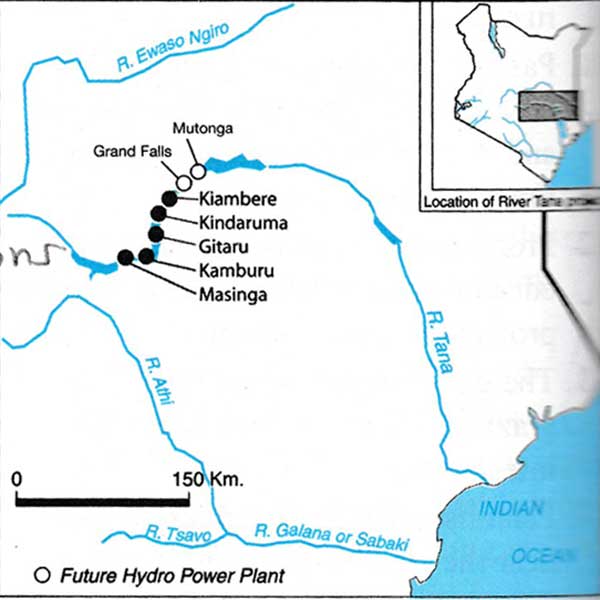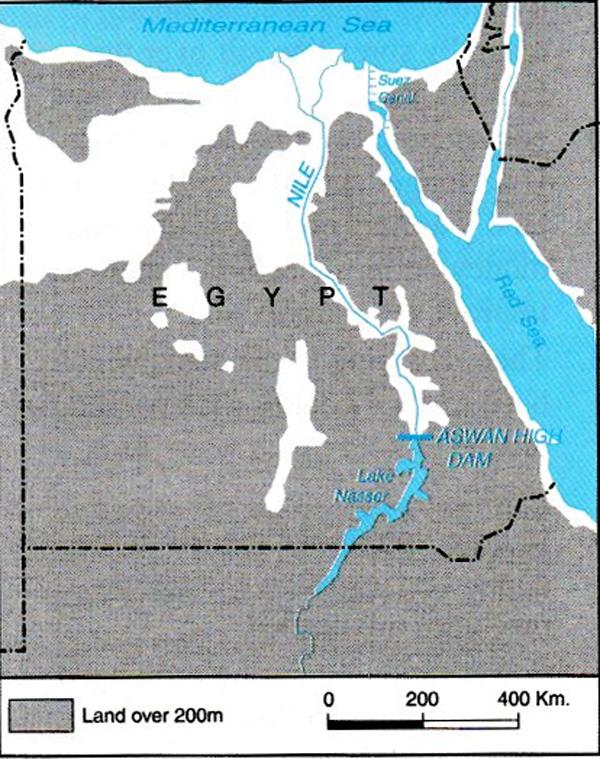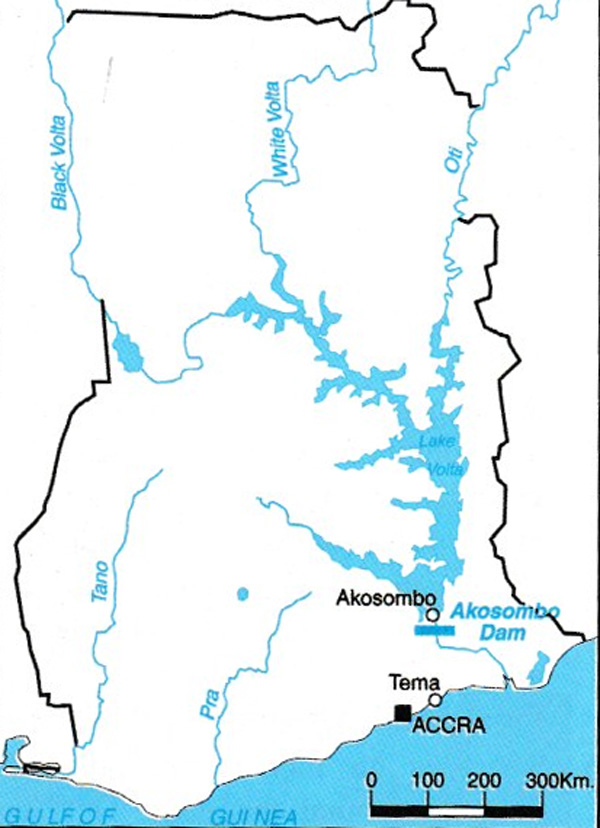- Multi-purpose projects are dams that are built across rivers and used for more than one purpose. For example, some dams are constructed for the purpose of generating electricity.
- After they are completed,they end up serving other purposes like controlling floods, providing water for irrigation and for fishing.
a) River Tana Projects
b) Aswan High Dam Project
c) Volta River Project
d) Kariba Dam Project.
- River Tana Development Project was planned to be developed in seven different phases.
- Therefore, it was known as the Seven Forks Project.
- Seven different dams were to be constructed at different locations along the river.
- Up to date, only five have been completed.
The figure below shows the location of dams along Tana River.

a) This project was mainly developed to produce hydro-electric power to meet the energy needs of the country.
b) To reduce the flooding of River Tana down stream.
c) To provide water for irrigation.
The series of dams built along River Tana have benefi ted Kenya in a number of ways which include:
a) Electricity generated at the power stations saves the country a lot of foreign exchange because hydro-electric power is an alternative to imported petroleum.
b) Electricity has enabled Kenya to expand the manufacturing industries and this has created employment opportunities.
c) Water that collect behind the dams (especially Lake Masinga and Kiambere Dam) is used for irrigating land during the dry season.
d) The lakes formed by the dams have become important tourist attractions, earning the country foreign exchange.
e) Fish farming has been introduced into Lake Masinga. This has improved protein intake of people living in the area.
f) Lakes provide water for domestic use.
g) The projects have created employment opportunities in agriculture for the people in the area.
h) The projects have led to the development of towns.
i) The lakes are used for recreation.
j) The presence of lakes has led to the development of improved vegetation.
k) Floods that used to be experienced in the lower Tana have been controlled because the dams regulate the fl ow of water.
Although this project has been of great benefi t to the people of the area, it has had some disadvantages. These include:
a) When the lakes were formed they flooded areas that were already occupied by people. The government had to spend money to resettle these people elsewhere.
b) The lower Tana used to fl ood annually spreading silt over the farming land. The dams have now controlled these floods and so this silt is no longer spread over the farming land. Farmers now have to spend money on fertiliser and manure to improve crop production.
c) There is silting in the dams which has made the lakes shallow and unable to hold much water. This affects the amount of electricity the water in the dams can generate.
d) In order to remove the silt, very expensive dredging machines are needed.
e) Power rationing during prolonged droughts has resulted from the dams not being able to hold enough water.
f) Water-borne diseases like bilharzia and malaria result from the stagnant water around the lake.
- This is a rock-fi ll dam which was constructed across River Nile in Southern Egypt.
- This kind of a dam is built by piling up rocks across a river to block the water. Small gates are left in the dam to regulate the fl ow of the river.
- The construction of the Aswan High Dam led to the formation of Lake Nasser which is over 500 km long and spreads into Northern Sudan.
- Work on the dam started in 1956 and it was completed in 1970. It is the oldest multi-purpose project in Africa.

a) The main reason was to use Africa’s largest river to generate electricity. Before the dam was built, Egypt depended on imported petroleum to generate electricity.
b) Egypt needed a reliable source of water for irrigation. Ninety six percent of Egypt is a desert. For many centuries, the country has depended on traditional methods of irrigation to farm its land. However, this was only to produce subsistence crops. If large scale irrigation was to take place, then a dam was required to provide the badly needed water.
c) Heavy rainfall in Eastern Africa used to cause annual fl oods along River Nile in Egypt. These fl oods used to displace people and affected farming activities. A dam across the Nile would regulate the fl ow of River Nile.
1. The dam generates 2 000 megawatts of hydro-electric power for domestic and industrial use. Egypt has been able to manufacturing as well as iron and steel processing.
2. Irrigation of arid land has led to the production of large amounts of crops like cotton, maize, millet, rice, dates and beans.
3. Cotton is grown as the main raw material for the textile industry in Egypt. Egypt’s quality of cotton is among the best in the world.
4. The project has controlled annual fl ooding of the River Nile.
5. Industries and agricultural activities have increased employment opportunities in the country.
6. Water from Lake Nasser now irrigates over 10 000 hectares of land. As a result, Egypt is able to produce enough food to feed its people. Under irrigation, the country also produces enough wheat, rice, cotton, fruits and vegetables to meet its domestic needs.
7. Lake Nasser is an important source of fish.
8. Lake Nasser is an important water way, creating easy transport between Egypt and Sudan.
9. Forests have developed around the lake and this has improved the environmental beauty of the area.
10. The lake is an important tourist attraction which earns the country foreign exchange.
11. The presence of Lake Nasser has modified the harsh desert climate and attracted settlements.
a) Annual floods used to spread silt over farms and this improved the fertility of the land. Today farmers have to use fertilisers and manure in order to improve crop production.
b) Silt used to provide food for fi sh. The construction of the project has led to reduced fish production in the River Nile.
c) Silt was an important raw material for pottery and brick Industries. After the damwas constructed, brick manufacturing is no longer an important industry along the Nile Valley.
- This Project is found on River Volta in the Southern part of Ghana.
- The river fl ows through an area that experiences seasonal rainfall. It was developed in order to store rainwater for use during the dry season.
- The project involved the construction of a dam at Akosombo. As the river flows between Togo Mountains and Akwapim Hills, it forms a narrow valley with sides of hard rock.
- This was a good site because it was cheap to build a short dam across the narrow river valley.
- The lake that formed would also have a strong base. Construction begun in 1962 and was completed in 1966.
- The dam formed Lake Volta which is the largest artifi cial lake in the world.
- The dam is 134m high and 426m wide and about 400 km long.
The Akosombo Dam

a) The dam was built in order to regulate the flow of River Volta by storing water during the rain season for use during the dry season.
b) To control the fl ooding of River Volta in Southern Ghana.
c) To generate electricity in order to mine bauxite in Southern Ghana and refi ne it into aluminium.
d) To reduce the use of imported petroleum to generate electricity. This was the main source of electricity in Ghana before the project, and it was very expensive.
e) There were many cases of river blindness among the people living along the banks of the river. This was caused by a fly that breeds in the River Volta valley. Lake Volta could drown the river valley and reduce the breeding grounds for the fly.
a) The Akosombo dam generates electricity and this has led to the development of new industries.
b) Lake Volta stores water for irrigation, industries and domestic use.
c) Lake Volta is an important means of water transport between the Northern and Southern parts of Ghana.
d) Fish was introduced in the lake and is now an important source of protein. The species of fi sh found in the lake include, the Nile perch, tilapia and mud fish.
e) People moved and settled on the shores of the lake where conditions had improved.
f) Cases of river blindness have reduced. g) Because of the availability of electricity, industries have developed at Tema, Accra, Akosombo and other parts of Southern Ghana.
h) Employment opportunities were created for the people of Ghana. This improved their standards of living.
i) Power made mining and processing of bauxite much cheaper. Bauxite is the main mineral export of Ghana. j) Generating electricity at Akosombo reduced Ghana’s dependence on imported oil.
k) Hydro-electricity that is exported to the neighbouring Togo and Benin earns Ghana foreign exchange. l) The Volta Aluminium Company, which uses most of the power produced at the dam, contributes revenue to the state in form of taxes. m) Irrigated plains around Accra and Afram now produce food for domestic use and cash crops for export.
- Kariba Dam Project is found on River Zambezi, which is on the border between Zambia and Zimbabwe.
- The river fl ows through a narrow gorge after the Zambezi Falls and this provided good site for the construction of the dam.
- Work on the dam started in 1955 and was completed in 1959.
- The dam is shaped like an arch and is 610 m long and 128 m high. Lake Kariba formed behind the dam.
- This lake is about 285 m long while the widest part is 40 km. Lake Kariba is the world’s third largest artifi cial lake.
- Zambia is the leading producer of copper in the world. In order to mine and refi ne copper, Zambia used to generate electricity from petroleum.
- This was very expensive. Zimbabwe too, had to import large amounts of oil to produce electricity for local demand.
- The two countries needed a project that would generate electricity more cheaply.
a) The project generates power for Zambia and Zimbabwe. This has led to the growth of industries in the area.
b) The development of industries has created jobs for the people of the area. This has improved their standards of living.
c) The construction of the dam together with the beautiful Victoria Falls has made the area a big tourist attraction.
d) The lake is a major source of fi sh for the people in the area.
e) The construction of the dam led to the development of Lake Kariba behind the dam. This modified the climate around it.
f) The area around the project is home to a variety of wild animals like elephants, baboons, buffaloes and different bird species.
g) The project has led to the development of Kariba town with many tourist hotels and lodges. It has also attracted settlements around the lake.
h) It has regulated the fl ow of River Zambezi which used to fl ood during the rainy season.
i) Forests have developed around the lake, improved the general environment and beauty of the area.
1. During construction in 1957, there was an accident that led to the flooding of the river valley killing many people who were involved in the construction work.
2. Over 5 000 wild animals had to be relocated from the valley. This operation to move the animals became known as Operation Noah and it cost the two countries a lot of money.
3. The dam displaced over 57000 people who had to be resettled elsewhere and compensated. This was expensive.
4. Water-borne diseases like bilharzia and malaria resulted from the stagnant water around the lake.